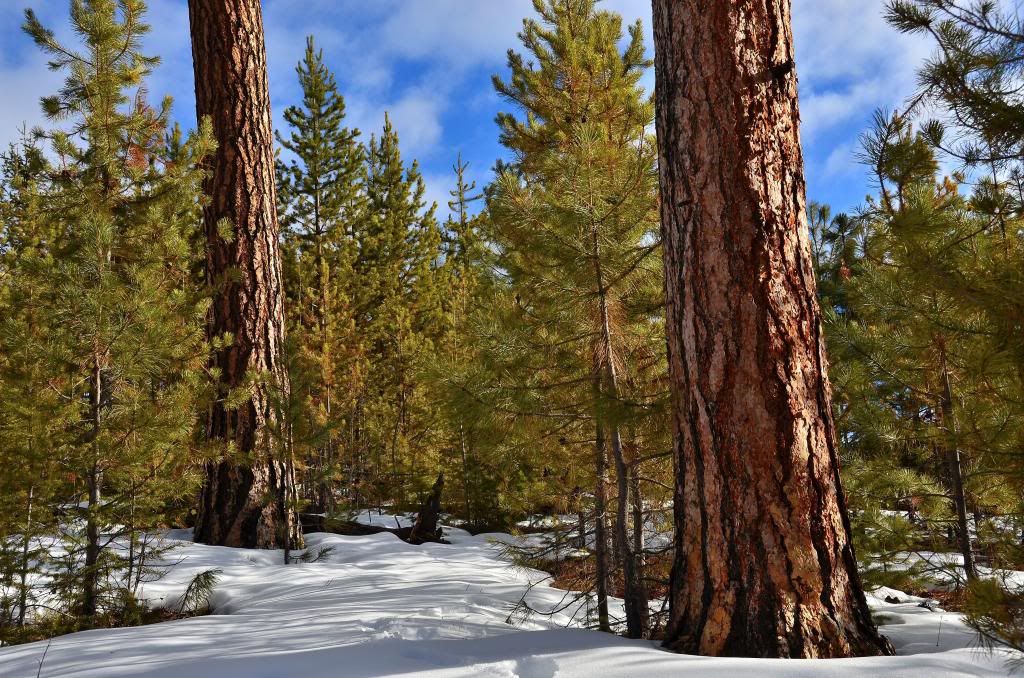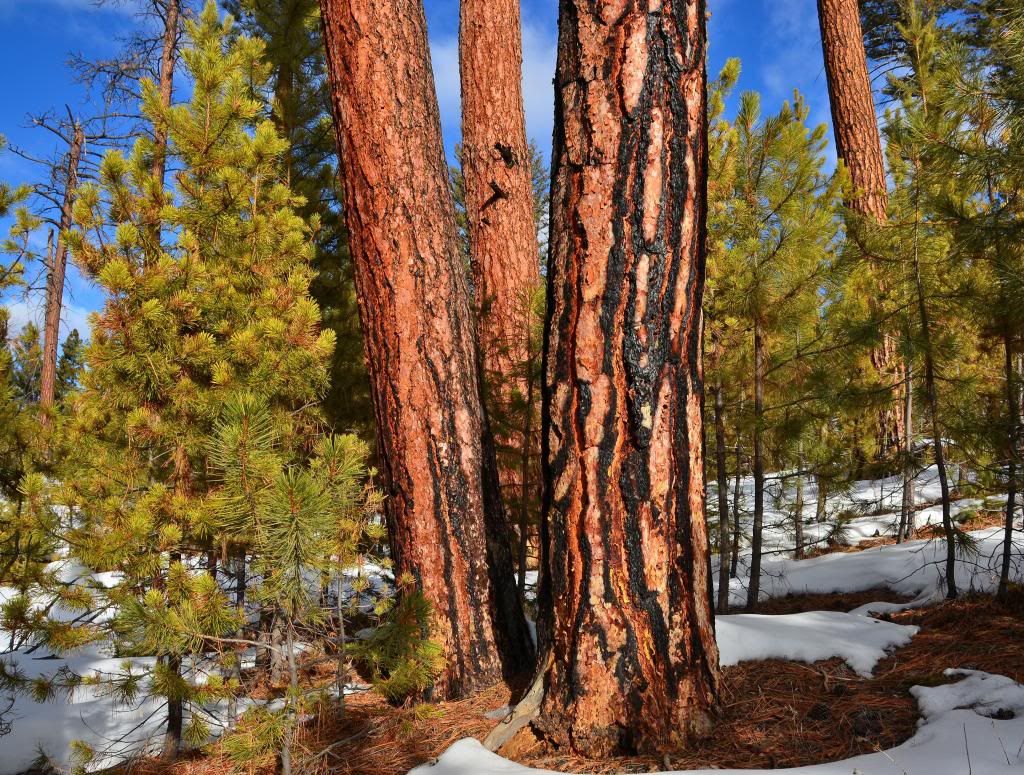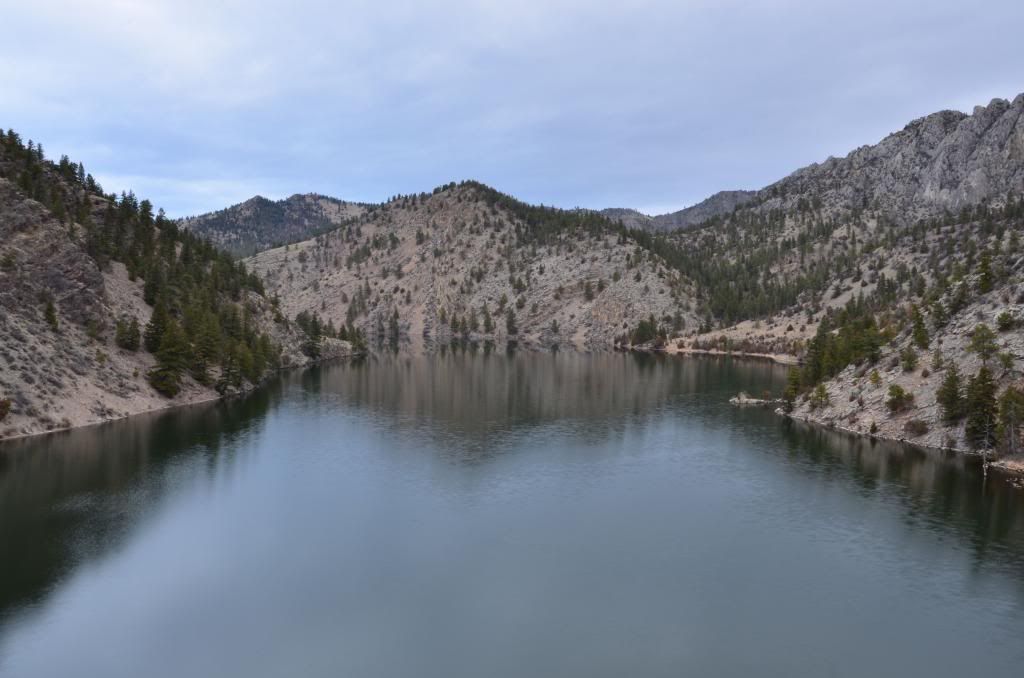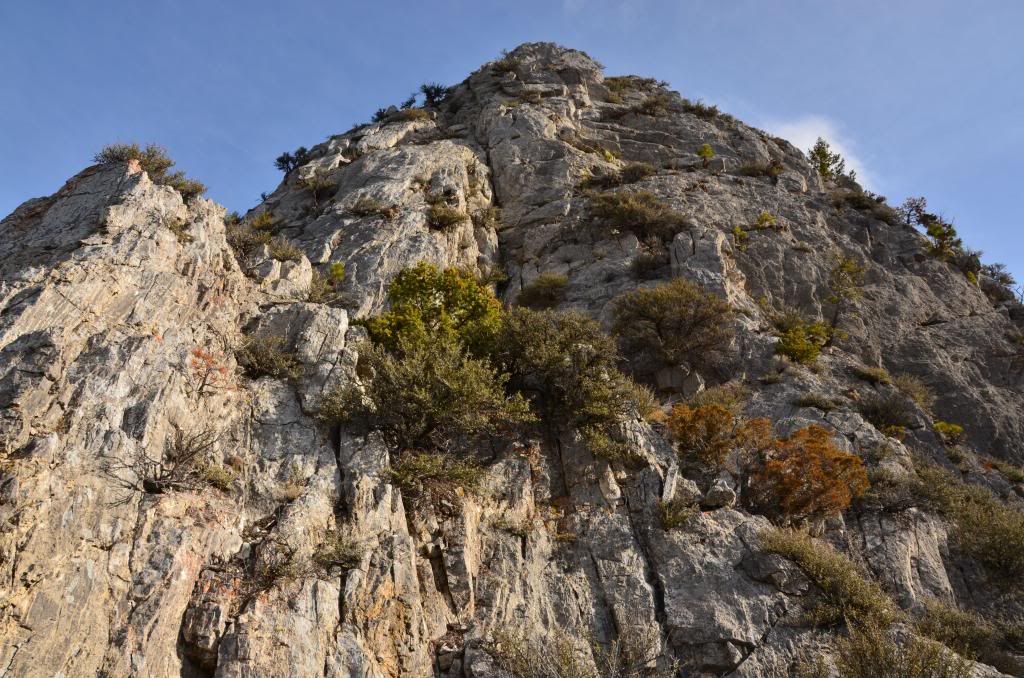Beautiful places and images as usual, Brian! From my perspective, interesting to see all that bare ground at this time of year!
Here is what it looks like here today- luckily the snow seems to have stopped early, though there could be a couple cm more possible tonight- we got at least 15cm/6 inches of fresh snow, and a taste of what folks in warmer places have to deal with- it was wet, heavy snow, glad to be finished the shovelling..... Of course the amount was not that extreme, but the area we have to shovel is extensive- the last view shows only one part of it- maybe 1/4...
Both those sort of extremes are very different to a day spent planting snowdrops here in the sun - last night's low was still only -3°C! So a bit of sunshine - this is a Turkish Crocus, herbertii, unusual in that it is stoloniferous; about the strongest orange of all crocuses. Actually very hardy - Janis Ruksans speaks of growing this under apple trees in Latvia for over 20 years, where winter temperatures can drop to -30°C or lower (and presumably at times where snow cover is erratic). It's a great plant!
I think you win Fermi! The only thing I can imagine beating that is one of those vivid flourescent cacti, or perhaps a Denver Delosperma; I have neither.
I was going to photograph Eranthis hyemalis in bloom but it's now under a lot of snow. Oh well ....
I know what you mean Anne, I was going to photograph Colchicum kesselringii which started blooming, now it's under 18" (45 cm) new snow from our surprise blizzard last night and today.
Frustrating, it's the weekend, sunny and warm (46 F 52 F), the snow is melting, but there's still a foot or two (depending on drifts) of white stuff. So, I do some armchair botanizing. My image for the day is via a single Flickr link, color forms of Calochortus venustus, all found in one location in Fresno, California: http://www.flickr.com/photos/20264760@N07/sets/72157603110884706/
Brian, please tell us where this totally unique and surreal scene is. How unusual for those vaiously colored boulders to be sitting atop pilasters of apparent sediment, what can you tell us about those formations. The area looks inhospitable to plants, but can't always tell from afar, does the area support some unique flora?
The area is just south of Helena Montana. It is only a very small part that looks like this. When I first discovered the place, I was amazed by the incredible rock formations. It seems out of place with the surrounding landscape. I'm not a geologist, so I can't make too many comments on what type of rock it is and how it formed. It looks like the floor of an ancient sea that was later carved by a river. The course of the river changed a long time ago, but it left rocks in the floor of the canyon, and these have slowly eroded away to form the pedestals.
The area looks barren, but I find plants that are associated with the badlands: Phlox hoodii, Phlox alyssifolia, Astragalus gilviflorus, Oneothera caespitosa, Penstemon nitidus, Mentzelia decapetala, Oxytropis besseyi, Eriogonum mancum, Eriogonum ovalifolium, Townsendia hookeri and Douglasia montana (this last species seems very out of place here). On the hike to this area, there are thousands of Lewisia rediviva. I will take more photos once things start to bloom.
Yes, a surrealistic landscape. I believe those pillars is carved by rain? The loose sediment is washed away by rain and only what's protected by the rocks is undisturbed. Here are something similar from Norway: http://no.wikipedia.org/wiki/Kvitskriuprestan
A few more photos of the incredible dreamscape. It's a perfect place for me to contemplate the important things in life--plants, rocks and photography (I have a one-track mind).
Great photo of A. jonesii. It is one of my favorite native plants.
I visited the Big Belt mountains here in Western Montana Saturday morning to see if Kelseya uniflora was in bloom. There are buds, but the recent cold spell will stall things for another month. Attached are some images:
This colony is around 6 or 7 from seed. In this location they grow in almost pure gravel, no organics at all(that i know of). I do not use any fertilizer and only rarely do supplemental watering. so, pretty harsh.
Nice pictures of the Big Belt mountains, i love that place. i am surprised there is not more snow there still. I took a few pictures of plants that are just now in flower in my garden.
This colony is around 6 or 7 from seed. In this location they grow in almost pure gravel, no organics at all(that i know of). I do not use any fertilizer and only rarely do supplemental watering. so, pretty harsh.
Many thanks for that, Jim. I shall have to be considerably less kind to my tiny plant (purchased from Gerd Stopp in Germany).
Well on the basis that I have a similar plant of Lomatium columbianum in the garden, it means I should have no trouble with Aquilegia jonesii... has anyone succeeded with it like that in the UK?
Nice stuff Brian and Jim! Good reminder when going through seed lists looking at plants that might be able to take my minimum temperatures- to remember that your growing season starts 3 months earlier (an exaggeration, earliest natives here start in mid-late april, though that is very very few and by mid-may things are really just getting going) - probably goes much later too...lol
One of the things i was concerned about is the ability of Lomatium columbianum to withstand rather cold temps that we can have here in Idaho. This winter we had an extended period of subzero temps(F) that went down to -15F but this did not seem to have any effect on this plant. I would say that this plant is hardy to at least these temperatures. Another plant that i was watching was Astragalus coccineus. It was my thinking that this plant may not be hardy even though these seeds were from a northern part of the population. i can report that i did not loose one single plant of this species, which is odd since i usually loose at least one over winter. go figure.
Maybe it prefers some sustained cold rather than up and down temperatures? Jim, have you ever tried Lomatium martindalii? (not sure of the spelling but a beautiful plant. Would really love to hear of someone having success with this so I could find out how to grow this. I do have Lomatium grayi, wich seems to be very hardy and a lovely plant with yellow bloom and an airy cloud of foliage.
Comments
Lori S. (not verified)
Re: Image of the day - 2013
Thu, 02/21/2013 - 4:32pmNB. "Mud swallow" = cliff swallow. They occur here too in breeding season, nesting on banks, under bridges, etc.
Nice photos!
Brian_W (not verified)
Re: Image of the day - 2013
Sun, 03/03/2013 - 1:34pmThree photos from my hike yesterday. I want to take more photos today but the wind is too strong.
I call this series "Tooth and Stone"
http://i1072.photobucket.com/albums/w362/townsendia/Nikon%20d7000/036--r...
http://i1072.photobucket.com/albums/w362/townsendia/Nikon%20d7000/008--r...
http://i1072.photobucket.com/albums/w362/townsendia/Nikon%20d7000/032--r...
Brian_W (not verified)
Re: Image of the day - 2013
Sun, 03/03/2013 - 3:24pmThese two were taken Friday. It was very cold and windy.
http://i1072.photobucket.com/albums/w362/townsendia/Nikon%20d7000/025--r...
http://i1072.photobucket.com/albums/w362/townsendia/Nikon%20d7000/039--r...
cohan (not verified)
Re: Image of the day - 2013
Sun, 03/03/2013 - 4:14pmBeautiful places and images as usual, Brian! From my perspective, interesting to see all that bare ground at this time of year!
Here is what it looks like here today- luckily the snow seems to have stopped early, though there could be a couple cm more possible tonight- we got at least 15cm/6 inches of fresh snow, and a taste of what folks in warmer places have to deal with- it was wet, heavy snow, glad to be finished the shovelling..... Of course the amount was not that extreme, but the area we have to shovel is extensive- the last view shows only one part of it- maybe 1/4...
Brian_W (not verified)
Re: Image of the day - 2013
Sun, 03/03/2013 - 7:17pmIt's been very dry this winter, especially in the valleys. Here are a few more. If it isn't obvious already, I like things that are very stark:
http://i1072.photobucket.com/albums/w362/townsendia/Nikon%20d7000/019--r...
http://i1072.photobucket.com/albums/w362/townsendia/Nikon%20d7000/025--r...
Trond Hoy
Re: Image of the day - 2013
Mon, 03/04/2013 - 9:50amBrian, I like that kind of landscape too! It is very different from what I'm used to.
Cohan, I'm glad I'm finished with shovelling snow for now although it is still possible to get some more ;)
Tim Ingram (not verified)
Re: Image of the day - 2013
Mon, 03/04/2013 - 10:45amBoth those sort of extremes are very different to a day spent planting snowdrops here in the sun - last night's low was still only -3°C! So a bit of sunshine - this is a Turkish Crocus, herbertii, unusual in that it is stoloniferous; about the strongest orange of all crocuses. Actually very hardy - Janis Ruksans speaks of growing this under apple trees in Latvia for over 20 years, where winter temperatures can drop to -30°C or lower (and presumably at times where snow cover is erratic). It's a great plant!
Trond Hoy
Re: Image of the day - 2013
Mon, 03/04/2013 - 11:46amTim, C. herbertii looks great! But does it tolerate a mix of humid and cold winter?
cohan (not verified)
Re: Image of the day - 2013
Tue, 03/05/2013 - 12:09amVery nice Crocus, Tim- one to watch for! Yes, planting snowdrops- anything outdoors- does sound very remote to me right now...lol
Fermi de Sousa
Re: Image of the day - 2013
Tue, 03/05/2013 - 7:27pmI'll "see" your crocus, Tim, and "raise" you a patch of Habranthus tubispathus!
;D ;D ;D
cheers
fermi
cohan (not verified)
Re: Image of the day - 2013
Tue, 03/05/2013 - 10:31pmBeautiful, Fermi! Is that blooming now?
Tim Ingram (not verified)
Re: Image of the day - 2013
Wed, 03/06/2013 - 8:07amI think you win Fermi! The only thing I can imagine beating that is one of those vivid flourescent cacti, or perhaps a Denver Delosperma; I have neither.
Trond Hoy
Re: Image of the day - 2013
Wed, 03/06/2013 - 10:30amFermi, brilliant!
David L (not verified)
Re: Image of the day - 2013
Thu, 03/07/2013 - 1:39amI will submit this for image of the day; Gentianella divisa growing on the Rock and Pillar Range, Otago
Brian_W (not verified)
Re: Image of the day - 2013
Thu, 03/07/2013 - 6:42amThere is still snow in the foothills of the mountains. The large ponderosa pines are survivors of a forest fire:


http://i1072.photobucket.com/albums/w362/townsendia/Nikon%20d7000/059--r...
http://i1072.photobucket.com/albums/w362/townsendia/Nikon%20d7000/065--r...
Mark McDonough
Re: Image of the day - 2013
Thu, 03/07/2013 - 7:46pmAwesome Gentianella David, brilliant photo.
Brian, Tim, Fermi, and others, been really enjoying the images posted here.
Cliff Booker
Re: Image of the day - 2013
Fri, 03/08/2013 - 6:11amSuperb shots folks ... much appreciated.
A simple snowdrop shot from me this time ...
Anne Spiegel
Re: Image of the day - 2013
Fri, 03/08/2013 - 2:50pmI was going to photograph Eranthis hyemalis in bloom but it's now under a lot of snow. Oh well ....
Mark McDonough
Re: Image of the day - 2013
Fri, 03/08/2013 - 4:31pmI know what you mean Anne, I was going to photograph Colchicum kesselringii which started blooming, now it's under 18" (45 cm) new snow from our surprise blizzard last night and today.
Lori S. (not verified)
Re: Image of the day - 2013
Fri, 03/08/2013 - 6:31pmGorgeous photos, everyone!
Anne and Mark:
Yeah, same thing here... Although bare ground was all I could have offered, photo-wise. :rolleyes:
Richard T. Rodich
Re: Image of the day - 2013
Fri, 03/08/2013 - 6:59pm--- Me too!
Trond Hoy
Re: Image of the day - 2013
Sat, 03/09/2013 - 12:37amVery nice Gentianella, David!
I like those pine trunks, Brian! I have planted one ponderosa pine in my garden. It hasn't reached such dimensions yet.
I heard of the blizzard you had over there - I am not jealous :o
Here it is just sun and cold.
Cliff, is it your place?
Here are some snowdrops in my garden yesterday evening. Too late to catch them open.
Cliff Booker
Re: Image of the day - 2013
Sat, 03/09/2013 - 11:20amUnfortunately not, Trond ... the image was taken in the beautiful Yorkshire Dales.
Mark McDonough
Re: Image of the day - 2013
Sat, 03/09/2013 - 11:58amFrustrating, it's the weekend, sunny and warm (
46 F52 F), the snow is melting, but there's still a foot or two (depending on drifts) of white stuff. So, I do some armchair botanizing. My image for the day is via a single Flickr link, color forms of Calochortus venustus, all found in one location in Fresno, California:http://www.flickr.com/photos/20264760@N07/sets/72157603110884706/
Lori S. (not verified)
Re: Image of the day - 2013
Sat, 03/09/2013 - 5:56pmIncredible colour variation, Mark!
Brian_W (not verified)
Re: Image of the day - 2013
Sun, 03/10/2013 - 4:04pmFrom yesterday's hike:
http://i1072.photobucket.com/albums/w362/townsendia/Nikon%20d7000/140--r...
Mark McDonough
Re: Image of the day - 2013
Sun, 03/10/2013 - 4:19pmBrian, please tell us where this totally unique and surreal scene is. How unusual for those vaiously colored boulders to be sitting atop pilasters of apparent sediment, what can you tell us about those formations. The area looks inhospitable to plants, but can't always tell from afar, does the area support some unique flora?
Richard T. Rodich
Re: Image of the day - 2013
Sun, 03/10/2013 - 6:57pmThat is such a fantastical place! (magical + fantastic)
I'm sure every one of us is anxious for commentary.
Brian_W (not verified)
Re: Image of the day - 2013
Mon, 03/11/2013 - 5:46amGreetings,
The area is just south of Helena Montana. It is only a very small part that looks like this. When I first discovered the place, I was amazed by the incredible rock formations. It seems out of place with the surrounding landscape. I'm not a geologist, so I can't make too many comments on what type of rock it is and how it formed. It looks like the floor of an ancient sea that was later carved by a river. The course of the river changed a long time ago, but it left rocks in the floor of the canyon, and these have slowly eroded away to form the pedestals.
The area looks barren, but I find plants that are associated with the badlands: Phlox hoodii, Phlox alyssifolia, Astragalus gilviflorus, Oneothera caespitosa, Penstemon nitidus, Mentzelia decapetala, Oxytropis besseyi, Eriogonum mancum, Eriogonum ovalifolium, Townsendia hookeri and Douglasia montana (this last species seems very out of place here). On the hike to this area, there are thousands of Lewisia rediviva. I will take more photos once things start to bloom.
Brian
Anne Spiegel
Re: Image of the day - 2013
Mon, 03/11/2013 - 9:26amBrian, wonderful place - looking forward to the pictures to come.
Trond Hoy
Re: Image of the day - 2013
Mon, 03/11/2013 - 9:39amYes, a surrealistic landscape. I believe those pillars is carved by rain? The loose sediment is washed away by rain and only what's protected by the rocks is undisturbed. Here are something similar from Norway: http://no.wikipedia.org/wiki/Kvitskriuprestan
Brian_W (not verified)
Re: Image of the day - 2013
Tue, 03/12/2013 - 1:51pmA few more photos of the incredible dreamscape. It's a perfect place for me to contemplate the important things in life--plants, rocks and photography (I have a one-track mind).
http://i1072.photobucket.com/albums/w362/townsendia/Nikon%20d7000/016--r...
http://i1072.photobucket.com/albums/w362/townsendia/Nikon%20d7000/060--r...
http://i1072.photobucket.com/albums/w362/townsendia/Nikon%20d7000/selfpo...
cohan (not verified)
Re: Image of the day - 2013
Tue, 03/12/2013 - 11:55pmGreat spot indeed! Is that a little pine growing a couple of yards in front of you?
Brian_W (not verified)
Re: Image of the day - 2013
Wed, 03/13/2013 - 6:19amThat's a young rocky mountain juniper. The foliage turns reddish bronze in the winter.
Brian
Merlin (not verified)
Re: Image of the day - 2013
Fri, 03/15/2013 - 10:06amOne of the first Columbines to bloom in my garden, Aquiligea jonesii.
cohan (not verified)
Re: Image of the day - 2013
Fri, 03/15/2013 - 10:50amThanks, Brian.
Jim- wow- the young foliage is wonderful!
Richard T. Rodich
Re: Image of the day - 2013
Fri, 03/15/2013 - 1:35pmWho says there is no such thing as "blue roses"? ;)
Cliff Booker
Re: Image of the day - 2013
Fri, 03/15/2013 - 3:04pmMay I ask how old your magnificent plant is, Jim?
Brian_W (not verified)
Re: Image of the day - 2013
Mon, 03/18/2013 - 7:09amGreat photo of A. jonesii. It is one of my favorite native plants.
I visited the Big Belt mountains here in Western Montana Saturday morning to see if Kelseya uniflora was in bloom. There are buds, but the recent cold spell will stall things for another month. Attached are some images:
In the morning. Kelesya habitat in the upper right:

http://i1072.photobucket.com/albums/w362/townsendia/Nikon%20d7000/009--r...
A distant view, bathed in morning light. I could hike all day here and still not see it all:

http://i1072.photobucket.com/albums/w362/townsendia/Nikon%20d7000/098--r...
Limestone cliff habitat. It boggles my mind:

http://i1072.photobucket.com/albums/w362/townsendia/Nikon%20d7000/113--r...
Brian_W (not verified)
Re: Image of the day - 2013
Mon, 03/18/2013 - 1:58pmAn ancient limber pine clings to a chalky, windswept knoll:
http://i1072.photobucket.com/albums/w362/townsendia/Nikon%20d7000/055--r...
Richard T. Rodich
Re: Image of the day - 2013
Mon, 03/18/2013 - 7:05pmFascinating !!!!!!!!!!!!
Merlin (not verified)
Re: Image of the day - 2013
Tue, 03/19/2013 - 8:04amThis colony is around 6 or 7 from seed. In this location they grow in almost pure gravel, no organics at all(that i know of). I do not use any fertilizer and only rarely do supplemental watering. so, pretty harsh.
Merlin (not verified)
Re: Image of the day - 2013
Tue, 03/19/2013 - 8:39amNice pictures of the Big Belt mountains, i love that place. i am surprised there is not more snow there still. I took a few pictures of plants that are just now in flower in my garden.
Lomatium columbianum (from seed)

Draba not identified

Cliff Booker
Re: Image of the day - 2013
Tue, 03/19/2013 - 10:50amMany thanks for that, Jim. I shall have to be considerably less kind to my tiny plant (purchased from Gerd Stopp in Germany).
Tim Ingram (not verified)
Re: Image of the day - 2013
Tue, 03/19/2013 - 11:04amWell on the basis that I have a similar plant of Lomatium columbianum in the garden, it means I should have no trouble with Aquilegia jonesii... has anyone succeeded with it like that in the UK?
cohan (not verified)
Re: Image of the day - 2013
Wed, 03/20/2013 - 12:17pmNice stuff Brian and Jim!
Good reminder when going through seed lists looking at plants that might be able to take my minimum temperatures- to remember that your growing season starts 3 months earlier (an exaggeration, earliest natives here start in mid-late april, though that is very very few and by mid-may things are really just getting going) - probably goes much later too...lol
Trond Hoy
Re: Image of the day - 2013
Wed, 03/20/2013 - 1:20pmPretty Lomatiums!
Merlin (not verified)
Re: Image of the day - 2013
Wed, 03/20/2013 - 1:27pmOne of the things i was concerned about is the ability of Lomatium columbianum to withstand rather cold temps that we can have here in Idaho. This winter we had an extended period of subzero temps(F) that went down to -15F but this did not seem to have any effect on this plant. I would say that this plant is hardy to at least these temperatures. Another plant that i was watching was Astragalus coccineus. It was my thinking that this plant may not be hardy even though these seeds were from a northern part of the population. i can report that i did not loose one single plant of this species, which is odd since i usually loose at least one over winter. go figure.
Anne Spiegel
Re: Image of the day - 2013
Sat, 03/23/2013 - 9:30amMaybe it prefers some sustained cold rather than up and down temperatures? Jim, have you ever tried Lomatium martindalii? (not sure of the spelling but a beautiful plant. Would really love to hear of someone having success with this so I could find out how to grow this. I do have Lomatium grayi, wich seems to be very hardy and a lovely plant with yellow bloom and an airy cloud of foliage.
Anne Spiegel
Re: Image of the day - 2013
Sat, 03/23/2013 - 9:35amHere's a picture of it in bloom (in May).also throws some seedlings every year.
Pages